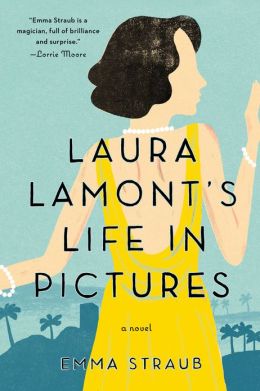Laura Lamont’s Life in Pictures, by Emma Straub
Those captivated by Old Hollywood will surely love Emma Straub’s debut novel, Laura Lamont’s Life in Pictures. The novel portrays an era when the veil of glamor was not easily pulled away, and is an appealing behind-the-curtain view of the transformation of a star from mere mortal to iconic screen persona.
The novel tells the story of Elsa Emerson, “the blondest, happiest accident,” who as a child in 1920s rural Wisconsin contentedly traipses behind her two elder sisters and the players who work in the family’s summer playhouse in Door County. From the start, Elsa understands there is “power in pretend,” and makes her first thrilling encounters with footlights, scripts, costumes, and naturally, applause. Following a marriage at seventeen to one of the traveling actors, Gordon Pitts, Elsa and her new husband board a bus to Hollywood. There, Gordon is signed on as a studio player, playing bit parts for a weekly salary. Soon, at a party, Elsa is spotted by a studio head, Irving Green, and in classic A-Star-Is-Born manner, Elsa is discovered, and she and Gordon are set on opposite trajectories.

The rise from obscurity to celebrity is a story that is both familiar and irresistible. When Green contracts Laura as a studio player, he arranges to have her pale blond hair dyed deep brown, a more “serious” shade and one he is certain will “set her apart.” Green is invested in the result, and supervises as the colorist works, instructing Elsa to close her eyes. When the colorist is finished, Elsa has her first look at her new identity as Laura Lamont:
Laura blinked a few times, and focused on the stained towel in her lap, her free hand clutching at her dress. She looked up slowly, and by the time she made it to her own face in the mirror, she knew that Irving had been right. Her skin had always been pink; now it was alabaster. Her eyes had always been pale; now they were the first things she saw, giant and blue.
The novel, Straub has said, was inspired after reading the obituary of Jennifer Jones, the legendary film actress who died in 2009. Like Lamont, Jones came to Hollywood from the Midwest, married a fellow actor at a young age, won an Oscar early on, and became the wife of a studio executive. In imagining Lamont, Straub endows her character with the sensitive disposition Jones was known for, though for Lamont, the fragility is ballasted with, naturally, determination. Once contracted to the studio, Laura’s beauty and sensitivity send her quickly to the top—and Irving Green, who becomes Lamont’s second husband, orchestrates much of her success.
Straub writes in a crisp, charming style, one that worked well in her 2012 collection, “Other People We Married.” Those stories tracked the lives of young twenty-something women making adult forays into the world, and are full of enchanting observations. In the novel, there are snappy asides, such as the description of an eager Boy Friday whose attentions are “like having a Labrador who could use his thumbs,” and insights that are endearing, such as when Elsa as a young newlywed thinks, “The idea she was married still seemed like a great big joke, a fiction she was able to pull over her head like an oversize sweater.”
Straub’s re-imagining of Hollywood (from 1938 to 1980) combines invention with factual detail (which she has attributed to the archives at the Margaret Herrick Library in Los Angeles). Yet for much of the novel, Laura remains at an emotional remove. For Laura, the twinned identities of Elsa Emerson and Laura Lamont are competing and often ambiguous, an influence perhaps of Jones’ tragic emotional instability. The premise makes for an excellent internal conflict, especially in a career where identity confusion can make it hazardous to step into the skins of others:
She was always two people. Elsa Emerson and Laura Lamont. They shared a body and a brain and a heart, conjoined twins linked in too many places to ever separate. Elsa wondered whether it would always be that way, or whether bits of Laura would eventually detach themselves, shaking off Elsa like discarded husk.
The competition between selves persists. Returning to Door County, Laura yearns to be Elsa again, but her livelihood depends on being Laura: “She saw herself through the twin lenses of a camera, at once upside down and right-side up, the edges of the frame flickering as they moved past, quicker than the eye could see.”
There is also an early family tragedy, a childhood loss that turns out to shape Laura’s choices in adulthood. As carefully incorporated as these threads are, they never quite bring Laura into focus, a focus this reader yearned for, since the facts, as well researched as they are, don’t make up for the sense of feeling what a character feels. In the end, the detail tells us what it’s like to be Laura Lamont: the feel of a silk dress, the delicate skin around her husband’s eyes, the ice in a cocktail.
—Lauren Alwan

